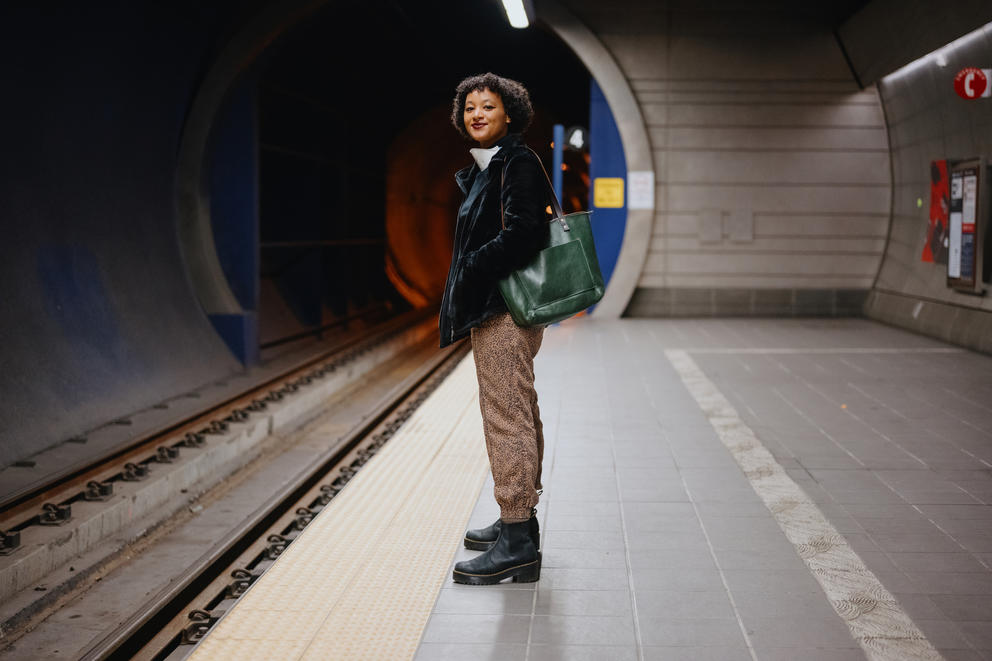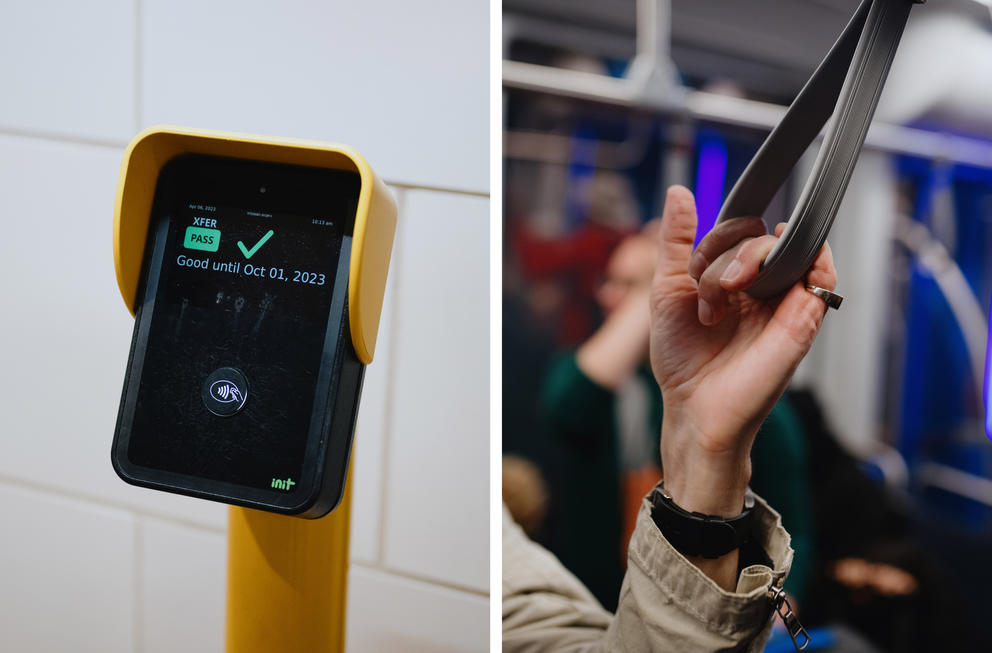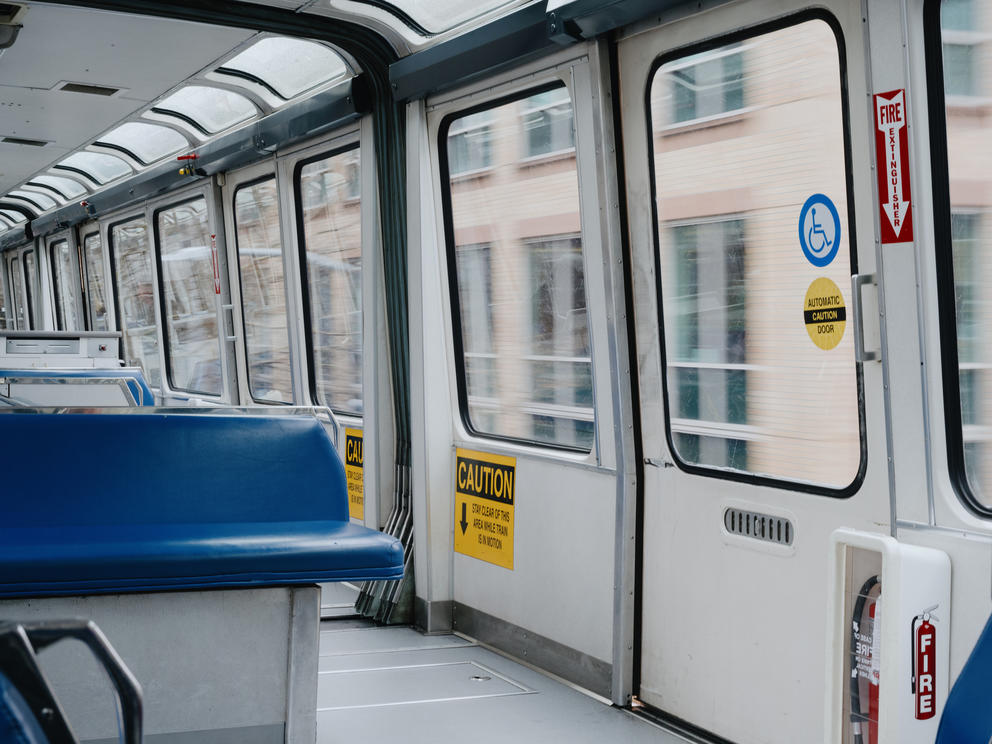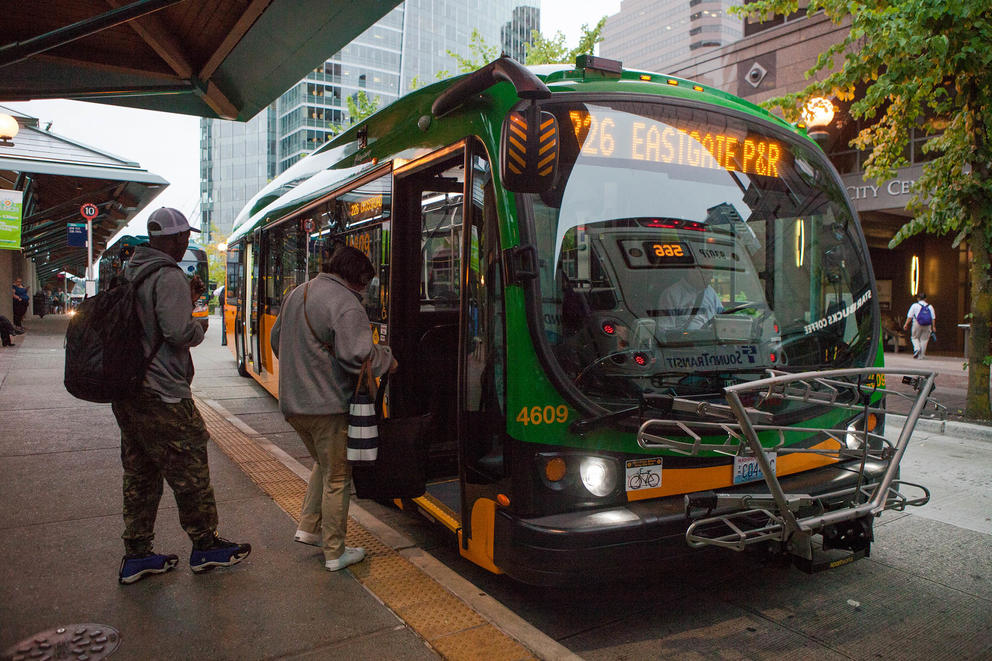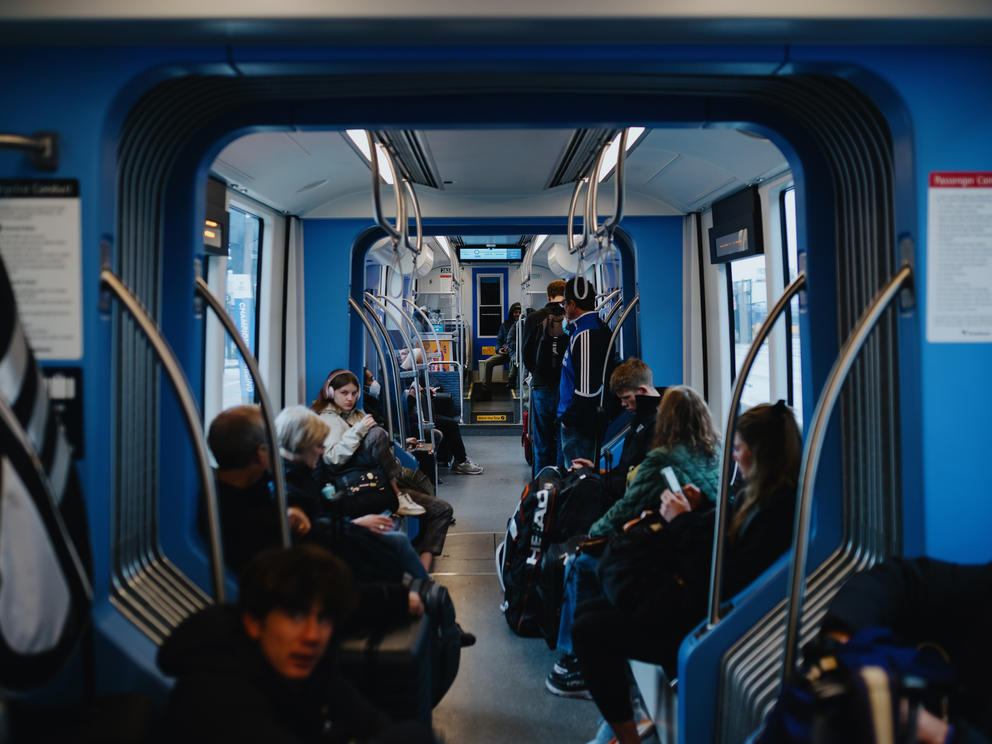Smith, who’s in her late 20s, doesn’t own a car and gets around the Puget Sound area by transit. She’s made a conscious life choice, one she believes others can make – if they plan carefully and learn a few tricks.
After we tapped our ORCA cards to pay for the ride and hopped on board the aging Jet Age conveyance, it whisked us from Seattle Center to the Westlake Link station. ORCA cards are the key to riding all flavors of regional transit. Most buses, trains and other conveyances do not accept cash, but you can buy virtual tickets online through the Transit Go app or pay for trips in a vending machine at a light-rail station.
As we hummed above cars sitting at stoplights on Fifth Avenue, Smith explained why she travels the region by bike, bus, train, ferry and on foot.
“It’s an economic choice, but also a values choice,” she said. “I have good public transit and I can get where I need to be, and orient my life around it. And, driving sucks. Parking sucks.”
Smith is one of 106 million riders who used King County Metro last year. Prior to the pandemic, the Seattle area led the nation in annual increases in ridership at a time when transit use was declining in many other cities. Although last year’s numbers were down from 2019’s peak of 123 million riders, Metro says usage is climbing steadily again even as usage patterns are changing dramatically.
As more people work from home, trips other than into downtown are becoming more in demand, as is one surprising growth area. “Weekend service is growing at a higher rate than weekday service,” said Chris O’Claire, mobility division director at King County Metro. She notes that sporting events such as Sounders, Seahawks and Mariners games are especially popular. In a partnership with Climate Pledge Arena, all tickets purchased for the venue’s events now come with a round-trip transit ticket, she noted. People who don’t commute for work but want to try transit for weekend activities might find Metro’s trip planner app or website useful.
But even though popularity is again surging post-pandemic, there are still concerns about cleanliness and safety, gaps in service, and the fact that for many trips – especially those involving one or more connections – it’s faster to drive.
“There are times when driving a vehicle is more time-efficient than riding the bus,” O’Claire acknowledged. “We have to speed up our service. So we’re looking at more bus lines and more partnerships with cities so that whether you're boarding the bus or moving the bus, it needs to be more competitive.” O’Claire said getting cities to add more dedicated bus lanes and transit-timed signals are among necessary changes.
Despite its faults, Smith likes the region’s transit network and says it successfully gets her where she needs to be – tabling as an organizer, going out with friends at night, or getting away for the weekend. “It's a system that works for me,” she said. “When you’re designing your life around it, you just need to be really intentional.”
How to ride
After Smith and I rode the monorail together, we took the stairs down from the monorail’s one Downtown stop to the Westlake Link station, arriving on the platform just as a Sound Transit car heading south pulled up. Note that you will need to tap your ORCA card again, on the station’s mezzanine, or buy a ticket on that level. And be sure to pay attention to the signs so you end up on the correct side of the platform. A special note for newcomers to the region: Learn your cardinal directions. You’ll need to know north, south, east and west to navigate our highways and transit. Seattleites know all this from birth and assume you do too.
We joined crowds of late-morning travelers on the train and rode to the Beacon Hill station. From there we walked half a block to the aptly named coffee shop The Station, which has become a bustling neighborhood hub.
Over coffee, Smith talked about transit essentials. The first thing to do, she recommends, is get an ORCA card.
She says her employer, Washington Bus (named for putting youth in the “driver’s seat” of politics, not for promoting transit issues), provides her with a monthly pass. If you’re an everyday weekday commuter and your employer doesn’t provide one, it will likely save you money to purchase a monthly ORCA pass (prices vary and can be found here). Many employers offer at least a transit discount because they have been strongly encouraged to do their part to decrease traffic in the region – and protect the environment – by getting their employees on the bus.
Those who use transit less regularly should purchase an “E-purse” ORCA card for $3 online or at any Link or Sounder train station, Smith says. You can load any amount between $5 and $400 onto the card with your debit card or credit card, and reload online or at train stations. An ORCA eliminates having to fumble with exact fare each time (many buses no longer accept cash, or if they do, do not make change, and trains do not have fare boxes). Bus and train fares around the region vary depending on distance, but generally start at $2.75. You can also buy one-time tickets on your phone with the Transit Go app
ORCA cards can be used to pay fares on all Sound Transit trains and buses; every bus run by King County Metro; the Seattle streetcar and monorail; and all transit in nearby Snohomish, Pierce and Kitsap counties. You can also use an ORCA to buy admission as a foot passenger on the King County water taxi to West Seattle and Vashon Island and on Washington State Ferries.
Last fall, Sound Transit, Metro, and many of the region’s transit agencies launched a free youth pass program in which anyone 18 and younger can ride the entire network for free. Children 6 and under don’t need to tap a card, while those between 6 and 18 are asked to order a free ORCA youth transit pass and tap each time they ride.
In addition, Metro offers discounted passes and fares to people 65 and older, people with disabilities, and riders who earn less than 200 percent of the poverty level. (To find out if you qualify, O’Claire recommends calling Metro at 206-553-3000.)
Smith also recommends using several smartphone apps to plan your rides. Google Maps, she says, is a good starting point to figure out the most direct route to your destination. Rather than using Metro’s official Trip Planner app, she prefers One Bus Away, which provides real-time arrival and departure times for all transit in the region. Smith is also a fan of Pantograph, which features visual representations of where every bus and train currently is in the system.
Smith is a regular user of Sound Transit’s Link light-rail system, which runs 26 miles from Northgate through Downtown and south to the Angle Lake station south of Sea-Tac Airport. The light-rail stop at the airport is a cheap and relatively convenient way to catch a flight. The system is scheduled to expand north to Lynnwood in late 2024, and expansions to Bellevue and Redmond on the Eastside and south to Federal Way are still under construction, with opening dates yet to be announced.
Sound Transit also operates longer-distance express buses all over the west Puget Sound region, and the Sounder weekday commuter-train service between Everett and Seattle and Tacoma and Seattle. Smith says she sometimes uses these or the Amtrak Cascades train system for weekend getaways, and recently took the train to Vancouver, B.C. “For another $5 you can bring your bike along,” Smith said. “I biked all around the city, did a little tour.”
A frequent bicycle rider, Smith says she’ll often make a local trip easier by putting her bike on one of the bike racks provided on every Metro bus or bringing it onto Sound Transit trains. Each bus rack can hold up to three bikes (and some smaller e-bikes will also fit). “Bus drivers are super-patient and friendly,” when you’re putting a bike in a rack, Smith says. “They’ll talk you through it if it's your first time.” She recently learned drivers prefer that you fill the bike slots farthest from the driver first. And make sure you remind the driver that you are picking up your bike as you exit the bus at your stop.
One relatively new service Smith hasn’t used but is curious about is Metro Flex. This app-based on-demand van system, operated by King County Metro, works similar to well-known ridesharing apps, but costs the same as a standard bus fare. Metro Flex operates within specific, limited service areas, including Juanita and Sammamish on the Eastside and five service areas in South Seattle/South King County: Othello, Rainier Beach/Skyway, Tukwila, Renton Highlands and Kent.
Formerly meant to connect people to transit stations, the Flex system now provides vans that travel from any point to point within those zones, says O’Claire. “We wanted to acknowledge that in areas like Tukwila, people might need to get from their home to the grocery store or from their home to a social service provider.” She said Flex is especially focused on areas with higher transit needs, including populations that include immigrants, people of color, or people with lower incomes.
Filling service gaps and improving safety
Smith said that while she appreciates Seattle’s transit system, she acknowledges there are plenty of gaps and weaknesses. She finds that east-west routes across the city are sometimes inefficient. Other areas get slow or infrequent service, and that shapes where she travels. “If I miss that connecting bus, is it going to be another half-hour for the next one?” she notes. “That’s why I don’t really go to Georgetown.”
Transit riders who are deaf or blind or both have more serious concerns, as Crosscut reported in 2021.
Smith frequently posts on Twitter about riding transit, and like many of her fellow social media transit geeks, a perennial issue is escalator and elevator outages at Link stations. “It’s a serious issue regarding vertical conveyance,” she said, “ It’s not only not reliable, but reliably unreliable. I know someone's going to post a picture of a broken escalator or elevator at least once every five days.”
According to Sound Transit spokesperson John Gallagher, the issue behind these outages is twofold. In the Downtown tunnel stations, many of these escalators and elevators are decades old and at the end of their expected lifespan. Parts are difficult to acquire and expensive. Sound Transit has a tentative $134 million, nine-year plan to replace that aging equipment.
“We certainly have made a lot of headway,” Gallagher said. “But we understand if you’re the person who’s standing at the elevator that’s not working and you need it, that’s still an issue. And we get it. We’re working as hard as we can to fix it.”
The second issue for newer equipment is vandalism and misuse, Gallagher said. “Unfortunately, people are doing things to or on escalators or elevators that they shouldn’t be doing,” he said.
Security, Gallagher said, is part of the solution, and he said Sound Transit has started a pilot program of station agents whose job is not only to monitor for misbehavior in Link stations but to assist riders.
Metro’s O’Claire said that security and cleanliness are ongoing rider concerns, and to that end the agency is launching a pilot program of “terminal ambassadors,” Metro operators designated to assist people at key bus stops. In addition, Metro has expanded its security staff from 70 to 100 officers and hopes to expand to 140 officers soon.
“We’re hearing there’s a desire among our community members for more of a safety presence on our system,” O’Claire said, but Metro is aware that security looks and feels different to various members of the community, especially people of color. “We want to make sure we balance respect for everyone on our system with an understanding of what’s the right way to ride our system.”
In a program launched this year, Metro is partnering with the King County Department of Community and Human Services to provide behavioral health services at the Aurora Village Transit Center and the Burien Transit Center. “We want to respond in a humane way that will really respect the individual and understand how to treat each other in this community space,” O’Claire said.
Other ongoing issues concern delays, and service changes that decrease frequency.
Katie Wilson, general secretary of the Transit Riders Union, a group that advocates for those who rely on transit, said that her members have noticed a significant deterioration in the frequency of service on some routes during and since the pandemic. “We're really worried about that,” Wilson said, “Part of this is actual reductions in service, but then the other part of that is the driver shortage.”
Nationwide, transit agencies are finding it difficult to hire and retain drivers and maintenance personnel, and Metro isn’t immune to this problem. “As of February, we need about 120 full-time [equivalent] transit operators,” O’Claire said, out of about 2,500 total drivers. Maintenance needs are even more critical, she said, and even more difficult to train. Metro is short 30 to 40 bus maintenance and repair staff out of a total of about 500.
This past fall, due to staff shortages, Metro announced reductions in service to about 60 different routes in the system.
Wilson believes Metro could do better than its current starting wage of $26 per hour for transit operators. “That's a decent wage, but given the level of housing costs in our region, it’s not a huge amount, she said. “If we’re going to be giving hiring bonuses to cops, maybe do the same for bus drivers?”
O’Claire said Metro is currently in bargaining talks with Amalgamated Transit Union Local 587 about both wages and scheduling. She said the agency is aware of a desire for more full-time drivers, as well as a need to restructure bus schedules from an emphasis on traditional peak commuting times to more regular service all day.
“We know from our riders that, for example, someone like me might come in [to a workplace] at lunchtime,” she said. “Maybe I do my morning at home and then commute in later. We know that the traditional commute has changed.”
That’s definitely true for Smith, who uses transit nearly every day and all times of day. She’s aware that service could be more frequent, but notes that even if buses and light rail take longer than a trip would by car, she sees that time as hers. “I can spend it how I want,” she said. “I can be working, reading email, or listening to audio books. I can utilize that time in a much better way than I could if I was driving.”
Get daily news in your inbox
This newsletter curates some of the most important headlines of the day from Crosscut and other news outlets.

